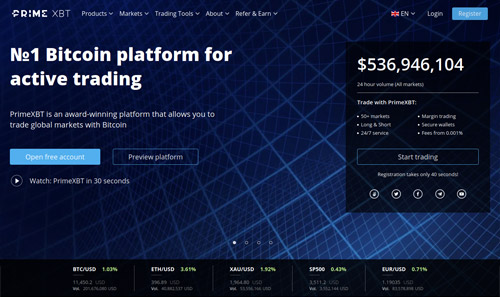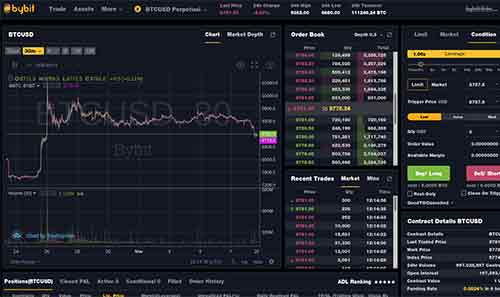Save Money With These Brokers:
Content:
What is Margin?
The term “margin” is used in credit-financed or leverage-based exchange trading. It is the amount deposited as collateral or pledge for a trade. In return for the margin, the trader receives a loan with which he can trade.
The term margin is commonly used in crypto trading, where leverage is used. “Trade on margin” means nothing other than betting on a certain price performance with a larger leverage amount.
If the bet goes wrong or the price develops unfavorably, it may be that the margin amount is too small and must be increased (margin call) or the position must be closed out. In the worst case, when not having used proper risk management, the trader is threatened with high losses.
Top 3 Bitcoin Margin Trading Platforms:
Please note that BitMEX now has KYC, so you need to verify your identity with photo ID / passport. Until February 2021 all customers must have sent their IDs, otherwise they will not be allowed to use the platform anymore.
What is Leverage?
Crypto leverage trading explained: The leverage is a capital loan from the Crypto broker and it is a multiple of the capital that you yourself use for crypto trading. Typical leverage ratios range from 5:1 to 100:1, so if we take a leverage of 100:1 as an example, the broker would lend you 100 bitcoin for every bitcoin you use for crypto trading. For example, if the exchange rate were to rise by one percent, you would make a profit of 100 percent on your capital investment.
Margin is a security deposit that you must deposit in your trading account. It is only a very small percentage of the trading volume that the broker uses as collateral. Depending on how high the chosen leverage is, the margin is between 50% and 1%. 1% it would be if you trade with the maximum leverage of 100x, which is offered by some brokers. However, this amount of leverage is never recommended. With a margin of five percent, for example, you only have to keep 0.05 BTC in your trading account as a margin, provided that you want to buy 1 BTC.
How does Cryptocurrency Margin Trading work?
The principle of Bitcoin or cryptocurrency margin trading is the following: The money you deposit on a broker platform can be used as maximum margin for your trade positions. This means it can be used as collateral or as the base stake you bring into trades from your side.
The actual position you can enter can be higher than your margin / stake. For instance, you can decide to trade with 5 BTC, although you only have 1 BTC as margin. In this case you would want to use a 5x leverage.
The 4 BTC that come on top of your margin will be a loan from the broker. So you are borrowing money on top of your stake in order to be able to trade bigger positions. That way you can potentially gain higher profits due to the bigger position. But of course there is an equally high risk of losses. It is also important to know that the level of leverage and the margin are directly related.
So the reason why margin trading is so popular, is the fact that you can trade with more money than your current stake to get the gains from such larger positions.
As a total beginner you might wanna read our article about bitcoin margin trading requirements.
What is the Relationship between Leverage and Margin?
There is a close connection between leverage and margin, because both variables depend on each other. To illustrate this, we would like to use the following three examples to show you how the two relate to each other:
- 20:1 (leverage) – leads to a margin of 5%.
- 100:1 (leverage) – leads to a margin of 1%.
- 400:1 (leverage)- leads to a margin of 0.25%.
The calculation is very simple: The leverage multiplied by the margin must always amount to 100. So if you have a leverage of 400:1, as in the example, multiplied by a margin of 0.25 percent, you get 100. So, in principle, based on the leverage estimated by the crypto broker, you can always calculate what the margin on the trading account must be.
If this is no longer sufficient, which is always the case if the price loss is higher than the percentage margin, many Crypto brokers work with a margin call.
Margin Calculation
In a margin deposit you can use borrowed capital for your own trading. Here we explain the basic functions of margin trading.
In a margin deposit, you have the opportunity to buy shares and other assets with borrowed capital and thus leverage your investment. In addition to the available cash, your eligible securities are used to determine whether a loan is possible. Collateral is generally the total value of all equity positions + the value of your cash holdings. The system requires cover (margin) for each stock position that you open.
If your position runs against you and the collateral deposited is no longer sufficient to meet the required margin, the system can automatically close out positions. There is no separate notification. For more information, see ” Automatic Spending Limitation.
Note: The lending of securities in a margin deposit requires a deposit value (equity incl. loan value, information on this under ” Account window) of at least USD 2000 or the equivalent value in another currency.
Margin cover is the minimum amount of collateral that must be available in your portfolio to cover it:
- the transaction is executed (initial margin) or
- the position can be held (Maintenance Margin).
In the trading platform, the value of the total collateral is displayed as Equity incl. Loan Value. This corresponds to the value of all stock positions + the value of your cash holdings.
In order to open a new position, the existing total collateral must be at least equal to the required initial margin. Read more.
You should always use a crypto margin calculator or crypto leverage calculator when trading CFDs on crypto platforms with high leverage.
Best Crypto Margin Trading Exchanges
One of the most important parts of crypto margin trading is the choice of the right broker. That’s why we also pay a lot of attention to this topic on this platform. As there are a lot of bitcoin leverage sites out there we’ve put together all the important information about each trading platform so you get kind of a in-depth comparison regarding their trading products, offers and features.
Check out our complete list of top crypto margin trading exchanges.
We also shed some light on where people can find crypto leverage trading in the USA.
Crypto Margin Trading Platforms without KYC
If you’re searching for brokers that don’t have to follow a kyc policy check our page about anonymous crypto trading.
Other tradeable Assets supported by Crypto Coin Margin Brokers:
Some cryptocurrency brokers not only offer Bitcoin and altcoin trading but also traditional assets trading such as Gold, Crude Oil, Stocks, Forex etc., in the form of Contracts for Difference (CFD). Those margin brokers are PrimeXBT and SimpleFX.
Trading Fees for the different Trading Platforms:
Check our comparison of Perpetual Contract Fees and Funding Rates. This site will help you to fully understand bitcoin margin funding rates as well as why and when you will have to pay them.
While we focus only on margin trading – you can find other crypto currencies to trade on this website.
How To Minimize Losses On Bitcoin Margin Trading
One of the most important factors when it comes to bitcoin and crypto trading is proper risk management. A lack of such is the no.1 reason why so many inexperienced traders fail in those extremely volatile markets while other achieve incredible gains.
Read how to minimize Losses on Bitcoin Margin Trading.
Learn more:
Margin vs Leverage: https://www.babypips.com/learn/forex/margin-vs-leverage
Margin Calculator: https://www.forex.com/en/support/margin-pip-calculator/
Funding fees: https://medium.com/hackernoon/5-minutes-before-funding-fee-33a853f8f9f2





